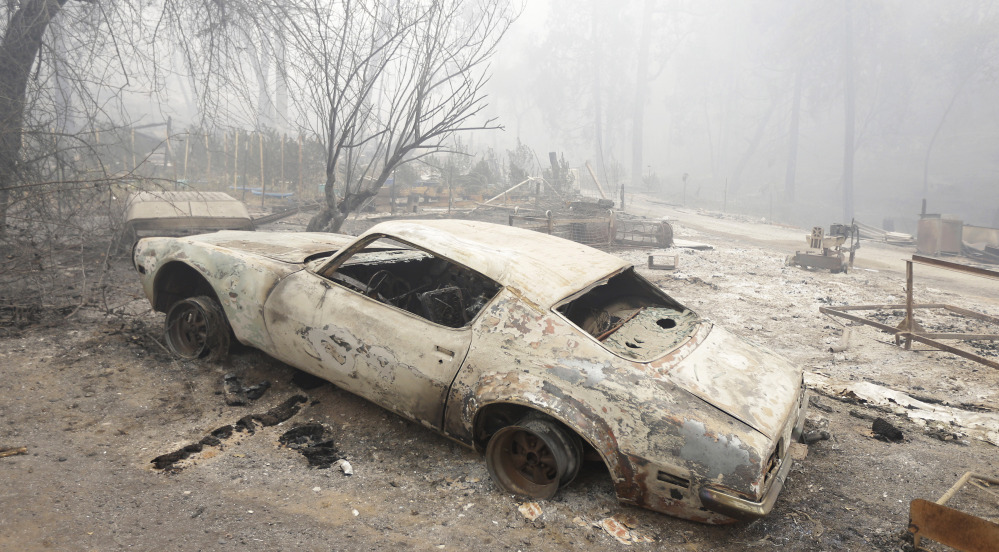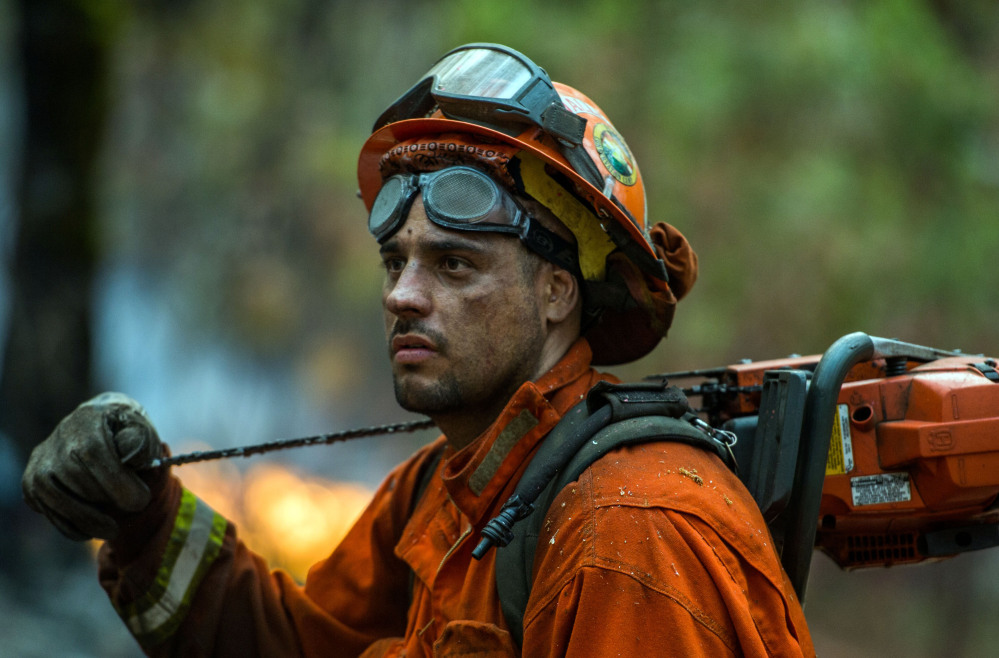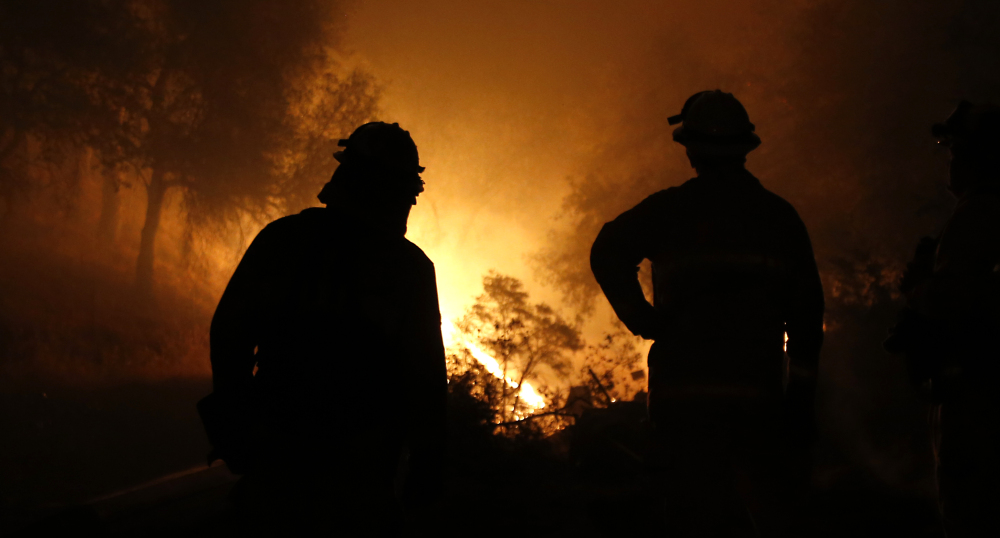When the emergency sirens wailed, Christine Perry muttered, “Oh, Lord, not again,” then scampered outdoors.
For a second straight year, a monster fire lurked outside her tiny town of Pateros, Washington. She strained to see whether thick smoke was rolling her way. A year ago, she barely escaped her house before it was destroyed by wildfire. After rebuilding, she feared it would happen again.
“Last year they told us we were safe. The next thing I knew, I was running out of the house in my flip-flops with the fire in the backyard,” she said.
The house didn’t simply catch fire, she said, “it exploded.”
Large wildfires are burning themselves into the memories of thousands of residents along the West Coast. In a region reeling from a historic drought, intense fires this year have raged from San Bernardino in Southern California, through Oregon, and up to Pateros near the Canadian border in northeast Washington, where Perry serves as mayor pro tem.
With more than a month remaining in the Western fire season, which starts each year in June, nearly 600,000 acres have burned in California. Washington is setting a record, with 990,000 scorched acres. And Oregon is on pace to match one of its worse seasons ever, with nearly 1 million acres burned.
Nationwide, more than 7 million acres have burned so far this year; the record is nearly 10 million in 2006. Fires in the Alaskan wilderness account for at least 5 million of the acres that have burned this year.
Never have so many acres burned with so much time left in the wildfire season. Across the country, the season has usually run from May through October, but climate change has extended the season from March to November, according to scientists and U.S. Forest Service officials.
California, Oregon and Washington are all in the throes of a severe drought. The mountain snow that normally replenishes rivers and lakes was so low in the three states that it burned away early and had little effect.
Wildfires are a natural part of forest ecology, serving a role in removing grasses and brush, and paving the way for new growth. But drought and higher-than-normal temperatures have robbed the ground of moisture, creating abnormally dry conditions that spark when lightning strikes and sometimes roar into mammoth blazes.
“This year there are many more fires that have threatened or are threatening communities, closing highways and freeways, impacting entire towns,” said Joe Hessel, of the Oregon Department of Forestry.
Some housing developments are controversial because they’re built near the edge of forests, placing them in the path of fires that burn naturally. But some of the recent fires have threatened homes that are far from areas that normally burn.
“They’re burning into towns,” Hessel said.
Perry was in her house on a hill overlooking downtown Pateros in July last year – 30 miles from the forest edge – when sirens blared and emergency crews rushed in to evacuate her neighborhood.
She barely had time to help rescue her 88-year-old mother, Marian, who lived next door. Thirty houses covering three blocks were wiped out by a fire called the Carlton Complex. “It felt like we were surrounded by a fire tornado.”
Perry said she’s one of five homeowners who rebuilt. A year later, in August, sirens announced the arrival of the Chelan Complex. “Oh, Lord,” she recalled thinking, “I do not want to do this again.”
The rebuilt house “looks like a hotel,” devoid of personal touches, Perry said, because she hasn’t replaced family photos lost in the fire. Her children sent digital images that she printed, but she said, “I can’t bring myself to put up personal pictures. Maybe I haven’t dealt with what happened.”
It’s rare that the Pacific Northwest experiences more acres destroyed by fire than California, but that’s what is happening this season.
California’s longer drought could be its salvation, said Richard Laton, an associate professor of hydrology at California State University at Fullerton. With so little precipitation, nothing grows after previous wildfires, so there’s little fuel to make fires grow.
“We’ve had about 1,000 more fires than usual, but they’re not big fires,” Laton said. “Worst-case scenario for us is a wet year that brings plants back, then we get a year of drought that makes them dry as hell.”
Still, California is having its “second-busiest season in a decade,” said Stanton Florea, a spokesman for the Forest Service’s Pacific Southwest Region.
Advances in firefighting is the main reason small fires aren’t spreading, Florea said. The same is true in the Northwest, Hessel said. But so many fires are burning in Oregon and Washington, and farther east in Idaho and Montana, that states are competing for money needed for firefighters and equipment.
Ninety-eight fires have met the “large fires” criteria of the Northwest Interagency Coordination Center that coordinates fire suppression in the Pacific Northwest. More than 1.5 million acres have burned in Oregon and Washington. A single fire, the Canyon Creek Complex, burned 110,000 acres in Oregon.
A single fire in Washington, the North Star, is still going after burning more than 210,000 acres. The cost of fielding 11,500 firefighters and support personnel to fight all the fires reached more than $550 million by late August.
“We don’t have enough folks to work the entire fire perimeter,” Hessel said.
So rather than fight a big fire where it’s burning, Oregon firefighters are ordered to back off and build a fire-suppression line miles away to slow the flames when they roar forward.
But that allows fires to burn longer and possibly larger, eating away private land that feeds livestock, produces timber and supports recreation that boosts the economies of small towns.
“We have fires out here that are 300,000 acres,” Hessel said.
Copy the Story LinkSend questions/comments to the editors.





Success. Please wait for the page to reload. If the page does not reload within 5 seconds, please refresh the page.
Enter your email and password to access comments.
Hi, to comment on stories you must . This profile is in addition to your subscription and website login.
Already have a commenting profile? .
Invalid username/password.
Please check your email to confirm and complete your registration.
Only subscribers are eligible to post comments. Please subscribe or login first for digital access. Here’s why.
Use the form below to reset your password. When you've submitted your account email, we will send an email with a reset code.